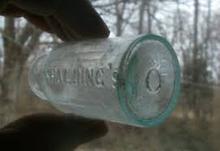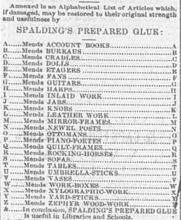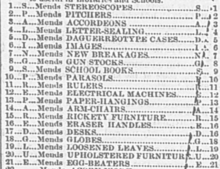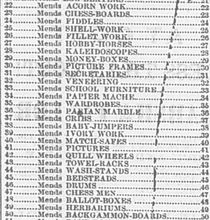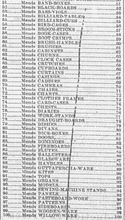Spalding’s Glue: “Useful in Every House” and Every Confederate Campground?
by Shivani Dimri
Wartime medicine chests stocked with anti-malarial treatments, painkillers, and anesthetics represented some of the most valuable advancements in nineteenth century medical science.1 Nevertheless, Confederate and Union leaders had much to worry about regarding the health and safety of their troops. More Virginian soldiers died from disease than from injuries sustained in battle during in the Civil War.2 Infection and illness spread through military campgrounds, and poor weather conditions and natural hazards afflicted the soldiers, as well.3
On April 21, 1861, William W. Minor Jr. wrote a letter to Mary L. Minor, William’s cousin and UVA Professor John B. Minor’s daughter. Writing from Harper’s Ferry in what was then still Virginia, William reported that his detachment was sent to Ohio to meet a train headed to Washington, D.C. and then to put out a forest fire. He noted that his detachment trekked through “the mountains as steep as a perpendicular wall & covered with loose rolling rocks…but thanks to my hardy raising I am all right still except that I have unfortunately knocked off 3 toe nails from my right & 2 from my left foot, & some 7 finger nails besides numerous bruises.” William reassured Mary in the letter’s postscript that he managed to mend his nails with Spalding’s Glue.4 Although Henry C Spalding & Co. did not create Spalding’s Glue with medical treatment in mind, Minor capitalized on the adhesive as if it were, nonetheless!
New York-based Henry C. Spalding & Co. manufactured “Spalding’s Celebrated Prepared Glue” as a product to mend household items in the 1850s and 1860s. If a soldier could have kept a bottle of the 25¢ glue around, it is not hard to see why he would resort to it to fix a minor injury like broken nails.5 With Confederate and Union women giving up linens and clothes to make into bandages, the scarcity of supplies may have discouraged soldiers from using them generously.6 Plus, Spalding’s Glue conveniently kept in all climates and did not require heating for use.7
But really, what was this glue supposed to be used for? Another Confederate soldier, Irby G. Scott of the Twelfth Georgia Volunteer Infantry, suggested in a letter to his mother that she use the glue to repair her broken ring.8 This use sounds more like what the manufacturers had in mind. Henry C Spalding & Co. ran an advertisement in Wheeling, VA (WV) newspaper the Daily Intelligencer listing a hundred uses, none of which encouraged contact with human skin, however.9*
Forget conventional bandages and adhesive plasters, Spalding & Co. could have declared, nothing matches the convenience of glue! After all, “Stationers, Druggists, Hardware and Furniture Dealers, Grocers, and Fancy Stores” alike sold this good.10
*Before applying Civil War-era Spalding’s Glue to human skin, please consult your druggist or medical professional.
Notes
1 T. A. Wheat, “Medicine in Virginia during the Civil War,” Encyclopedia Virginia, April 27, 2016, https://www.encyclopediavirginia.org/Medicine_in_Virginia_During_the_Civil_War.
2 Aaron Sheehan-Dean, “Virginia Soldiers (Confederate) during the Civil War,” Encyclopedia Virginia, October 27, 2015, https://www.encyclopediavirginia.org/Virginia_Soldiers_Confederate_During_the_Civil_War.
3 Wheat, “Medicine in Virginia during the Civil War.”
4 W W M Jr, “W W M Jr to Mary L Minor,” April 21, 1861, John B. Minor Papers, University of Virginia Library.
5 “Spalding’s Prepared Glue,” The Genesee Farmer XXI, no. 2 (1860): 231.
6 Glenna R. Schroeder-Lein, The Encyclopedia of Civil War Medicine (London: Routledge, 2008), 34.
7 “Spalding’s Prepared Glue,” Daily Intelligencer, December 15, 1859; “Spalding’s Prepared Glue,” 1860.
8 Irby Goodwin Scott, “Irby G. Scott to Mother,” April 11, 1862, in Johnnie Perry Pearson, ed., Lee and Jackson’s Bloody Twelfth: The Letters of Irby Goodwin Scott, First Lieutenant, Company G, Putnam Light Infantry, Twelfth Georgia Volunteer Infantry (University of Tennessee Press, 2010), 69–70.
9 “Spalding’s Prepared Glue,” December 15, 1859.
10 “Spalding’s Prepared Glue”; “Spalding’s Prepared Glue,” 1860.
M Jr, W W. “W W M Jr to Mary L Minor,” April 21, 1861. John B. Minor Papers, University of Virginia Library.
Pearson, Johnnie Perry, ed. Lee and Jackson’s Bloody Twelfth: The Letters of Irby Goodwin Scott, First Lieutenant, Company G, Putnam Light Infantry, Twelfth Georgia Volunteer Infantry. University of Tennessee Press, 2010.
Schroeder-Lein, Glenna R. The Encyclopedia of Civil War Medicine. London: Routledge, 2008.
Sheehan-Dean, Aaron. “Virginia Soldiers (Confederate) during the Civil War.” Encyclopedia Virginia, October 27, 2015. https://www.encyclopediavirginia.org/Virginia_Soldiers_Confederate_During_the_Civil_War.
“Spalding’s Prepared Glue.” Daily Intelligencer. December 15, 1859.
“Spalding’s Prepared Glue.” The Genesee Farmer XXI, no. 2 (1860): 231.
Wheat, T. A. “Medicine in Virginia during the Civil War.” Encyclopedia Virginia, April 27, 2016. https://www.encyclopediavirginia.org/Medicine_in_Virginia_During_the_Civil_War.
JUEL Sources:
Minor Letters, W_W_M_Jr_to_Mary_L_Minor_April_21_1861_Transcript
